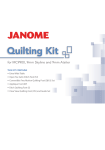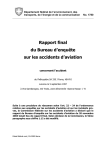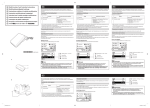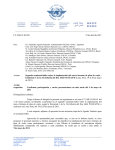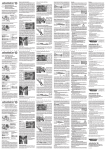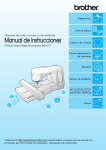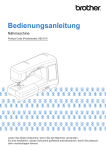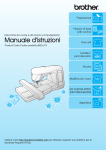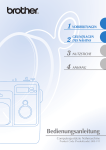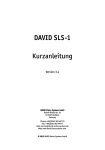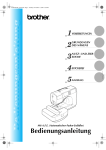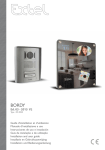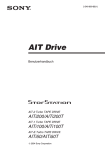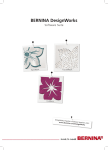Download Manual de instrucciones
Transcript
About the Circular Attachment ................................................................................................. Included Accessories ................................................................................................................ Attaching the Circular Attachment ............................................................................................ Sewing a Circle......................................................................................................................... Using the Quarter Circle Template ........................................................................................... Using the Included Presser Feet ................................................................................................ 2 2 3 3 5 5 Über den Einsatz zum Kreisnähen ............................................................................................ 8 Mitgeliefertes Zubehör.............................................................................................................. 8 Anbringen des Einsatzes zum Kreisnähen ................................................................................. 9 Nähen eines Kreises.................................................................................................................. 9 Anwendung der Viertelkreis-Schablone .................................................................................. 11 Anwendung der mitgelieferten Nähfüße ................................................................................. 11 À propos du guide pour couture circulaire.............................................................................. Accessoires inclus................................................................................................................... Fixation du guide pour couture circulaire ............................................................................... Couture d'un cercle ................................................................................................................ Utilisation du gabarit quart de cercle ...................................................................................... Utilisation du pied-de-biche fourni ......................................................................................... 14 14 15 15 17 17 Over het cirkelhulpstuk .......................................................................................................... Bijgeleverde accessoires ......................................................................................................... Het cirkelhulpstuk bevestigen ................................................................................................. Een cirkel naaien .................................................................................................................... Werken met de kwartcirkelsjabloon........................................................................................ Werken met de bijgeleverde persvoet ..................................................................................... 20 20 21 21 23 23 Informazioni sull'attacco circolare.......................................................................................... Accessori in dotazione............................................................................................................ Montaggio dell'attacco circolare............................................................................................. Cucitura di un cerchio ............................................................................................................ Utilizzo del modello del quarto di cerchio ............................................................................. Utilizzo dei piedini premistoffa in dotazione .......................................................................... 26 26 27 27 29 29 Información sobre la unidad para costura circular .................................................................. Accesorios incluidos............................................................................................................... Colocación de la unidad para costura circular........................................................................ Costura de un círculo ............................................................................................................. Utilización de la plantilla de cuarto de círculo ....................................................................... Uso de los pies prensatela incluidos ....................................................................................... 32 32 33 33 35 35 ESPAÑOL CONTENIDO ITALIANO SOMMARIO NEDERLANDS INHOUDSOPGAVE FRANÇAIS TABLE DES MATIÈRES DEUTSCH INHALT ENGLISH CONTENTS 1 Contents About the Circular Attachment This device can sew circular patterns that graduate out at 5mm intervals, ranging from 30mm to 130mm in radius* when the center needle position is selected. The device is set to the left of the needle on your sewing machine. Utility and decorative stitches can both be sewn using this device. * Radius= Distance from center of circle to any point on the circle. Note • You cannot use any decorative stitch with side feeding, or stitches over 7.0 mm in width. Use fabrics with a thickness of less than 4mm (approx. 3/16”). CAUTION • Special care is required for the pivot pin; Neglectful treatment may cause injury. Young children should be supervised to ensure that they do not play with the attachment. When attachment is not in use, always keep the pivot pin in the indicator to avoid its loss. Included Accessories No. 1 1 Part Name Circular Attachment a b c d e 2 3 Conversion Chart 4 5 6 Part Code - Indicator Handle/Flips Up Release button Setting position for pivot pin Scale 2 Pivot Pin XE6016-001 3 Attachment Screw (2pcs. one is extra) XE6022-001 4 Template XE6024-001 f Radius of circle in mm g Angular lines listed in degrees starting at 0 with 5 degree intervals h Center 5 Instruction Manual 6 Braiding Foot SA141/F021N This Manual 7 Cording Foot SA110/F013N mm (f) inch 130 5 3/16 120 4 3/4 Note 110 4 3/8 100 4 • We recommend that you use the extension table on your sewing machine for smooth fabric control. • Do not raise the extension table when the circular devise is attached. • The pivot pin may be released if you hold up the fabric while attached to the circular attachment. When holding up the fabric gently press down on the top of the pivot pin. • When sewing smaller circles or using fabric with a grain or uneven textures, a perfect circle may not be achieved. • Some of presser feet such as the side cutter cannot be used with this attachment, always test your accessory feet with the attachment. 90 3 1/2 80 3 3/16 70 2 3/4 60 2 3/8 50 2 40 3/2 30 13/16 7 • When using this attachment test the sewing speed of your machine for the best results. • When sewing larger pieces of fabric or garments, make sure that your fabric or garment does not get caught on the machine creating drag or distortion of your design. 2 a Sewing a Circle Place the circular attachment at left as shown in the figure. Note • Thread the machine needle before setting the pivot pin into the circular attachment. Threading lever may hit the pivot pin and damage the pin or the machines threading mechanism. → The two tabs on the underside of the attachment will drop down into corresponding holes in the needle plate, so that the attachment lays flat on the bed of your machine. 40 b a Raise the handle. b Slide the indicator to match the desired size of your circle. ENGLISH Attaching the Circular Attachment 30 Insert the screw on the circular attachment in the screw hole at the right of the needle plate (a). a Attachment Screw Securely tighten the screw with the discc shaped screwdriver included in your machine. Note • Do not slide the indicator by holding onto the pivot pin, doing so may cause the pivot pin to bend or break. a Disc-shaped screwdriver 3 c Use a piece of stabilizer that is larger than your design area, reinforcing with a smaller piece of the stabilizer at the center of the circle when using fine fabric or the same pivot pin area repeatedly. e Pressing the top of the pivot pin, insert the point of the pivot pin into the “Y” mark on the attachment. a Right side of Fabric b Wrong side of Fabric a b c d Wrong side of Fabric Stabilizer Reinforcement Stabilizer Pivot Pin area Note • A stabilizer is always required when sewing on any fabric or garment to prevent stretching or puckering. Depending on the type of fabric being sewn, will determine wether you use permanent, iron on, temporary or a sticky stabilizer. d f Select the desired stitch and sew allowing the fabric to feed smoothly, making sure that you do not push or pull your fabric causing an uneven circle. g After sewing, always press the release button to remove the pin and fabric from the circular attachment. Insert the pivot pin at the center of circle from the right side of fabric. a Pivot Pin b Center of circle c Right side of Fabric Note • When sewing a small diameter circle, we recommend that you first pin the fabric to the attachment and then set the indicator to your desired size. a Release button CAUTION • Do not leave the pivot pin inserted in your fabric and not attached to the circular attachment. To do so may result in accidental injury or machine damage. 4 When combining utility or decorative stitches, or repeating an individual stitch, use the included template as a guide. a Mark the pivot point (center of your circle) prior to sewing on the fabric (a). b Select your desired stitch and the size of a circle using the markings on the attachment, then place the fabric on the attachment. c Sew a single stitch or one pattern combination (b). d Remove fabric or garment from attachment. e With temporary pencil draw two lines from the pivot point, one at the start of your stitch pattern (c) and one at the end of the stitch pattern (d). a b c d f Pivot Point Single stitch/Pattern combination Start of the stitch End of the stitch Place the template on top of your design, lining up the center pivot point and the center marking on the template (a). Then place the 0 degree line on the right side of template (b) at the start of the stitch (c). g Check the line at the end of the stitch (d) and note the approximate degrees. With a circle measuring 360 degrees divide the stitch length (your degree/stitch measurement) into 360 and that will give you an approximate count on the stitch repetitions. SAMPLE: Your stitch is 16 degrees long so: 360 divided by 16 equals 22.5 repetitions. ENGLISH Using the Quarter Circle Template Note • This is not an exact count due to the number of variables i.e. stitch length, fabric used, thread and the stabilizer. You may be able to adjust the length of the stitch, depending on the stitch used, increasing or decreasing to get a closer match so that your circle closes without overlapping or shortage (a). • Always stitch a trial version of the design checking the stitch length, width and the direction of sewing, making sure that it is suitable for your project. • Additional calculations may be necessary if your pattern overlaps. Example: Shortage of the Pattern a End of the stitch Using the Included Presser Feet Using the included presser feet, you can embellish your sewing projects, giving them a professional look with your personal flair. ■ BRAIDING FOOT You can use a wide variety of braiding up to 5mm in width, using straight, zigzag and select decorative stitches. CAUTION • Do not use this foot when sewing with densely woven braiding that is difficult for the needle to penetrate easily. Doing so could result in needle breakage, damage and/or injury. a b c d Center on template 0 degree line Start of the stitch End of the stitch 5 a Loosen the screw on the guide plate sliding the plate to fit the width of the braid. ■ CORDING FOOT You can embellish using 1 to 3 cords of decorative threads or yarn. a Slip a cord from the right of the presser foot, into each guide (to use single cord, use the center guide). b Place the cords under and to the back of the cording foot. c Select a zigzag or decorative stitch and sew in a circular manner gently guiding the cords. a Plate b c 6 Insert the braid through the guide before attaching the foot onto the machine. Tighten the screw and pull the braid to the back of the braiding foot. d Attach the foot onto the machine. e Select the desired stitch and sew in a circular manner gently guiding the braid. Note • When sewing with zigzag or decorative stitches, adjust the stitch width, so that it is slightly wider than the width of the braid or cording. Über den Einsatz zum Kreisnähen ............................................................................................. 8 Mitgeliefertes Zubehör............................................................................................................... 8 Anbringen des Einsatzes zum Kreisnähen .................................................................................. 9 Nähen eines Kreises................................................................................................................... 9 Anwendung der Viertelkreis-Schablone ................................................................................... 11 Anwendung der mitgelieferten Nähfüße .................................................................................. 11 DEUTSCH INHALT 7 Inhalt Über den Einsatz zum Kreisnähen Mit diesem Einsatz können von einer gewählten mittleren Nadelposition aus Kreismuster mit einem Radius* von 30 bis 130 mm und in Schritten von 5 mm genäht werden. Der Einsatz wird an der Nähmaschine links von der Nadel eingesetzt. Dieses Zubehör kann für Nutz- und Dekorstichen verwendet werden. * Radius = Abstand vom Mittelpunkt des Kreises zu jedem möglichen Punkt auf dem Kreis. Hinweis • Dekorstiche mit Seitentransport oder Stiche, die breiter sind als 7,0 mm, können nicht genäht werden. Verwenden Sie Stoffe, die dünner sind als 4 mm (ca. 3/16 Zoll). VORSICHT • Der Ankerstift erfordert besondere Sorgfalt. Der fahrlässige Umgang kann zu Verletzungen führen. Achten Sie darauf, dass kleine Kinder nicht mit diesem Zubehör spielen. Wenn der Einsatz nicht gebraucht wird, den Ankerstift stets im Indikator aufbewahren, damit Sie ihn nicht verlieren. Mitgeliefertes Zubehör Nr. 1 1 Teilebezeichnung Einsatz zum Kreisnähen a b c d e 2 3 Umrechnungstabelle 4 5 6 Bestellnummer - Indikator Verschluss/klappt hoch Freigabeknopf Einstellposition für Ankerstift Skala 2 Ankerstift XE6016-001 3 Einsatzschraube (2 Stck., eine Ersatz) XE6022-001 4 Schablone XE6024-001 5 Gebrauchsanleitung 6 Spitzenfuß SA141/F021N 7 Kordeleinnähfuß SA110/F013N f Kreisradius in mm g Winkellinien in Grad, beginnend mit 0 und in 5-Grad-Schritten h Mitte Diese Gebrauchsanleitung mm (f) Zoll 130 5 3/16 Hinweis 120 4 3/4 110 4 3/8 100 4 • Es wird empfohlen, zur leichteren Stoffkontrolle den Ausziehtisch an der Nähmaschine zu verwenden. • Wenn der Einsatz zum Kreisnähen eingesetzt ist, den Ausziehtisch nicht anheben. 90 3 1/2 80 3 3/16 70 2 3/4 60 2 3/8 50 2 40 3/2 30 13/16 7 • Der Ankerstift kann durch Anheben des am Einsatz zum Kreisnähen angebrachten Stoffes gelöst werden. Beim Anheben des Stoffes leicht auf den Ankerstift drücken. • Beim Nähen von kleineren Kreisen oder mit grobem, ungleichmäßigem Stoff kann möglicherweise kein präziser Kreis erzielt werden. • Einige der Nähfüße, wie z. B. der Kantenabschneider, können mit diesem Zubehör nicht verwendet werden. Zubehörnähfüße immer zuerst mit dem Einsatz ausprobieren. • Wenn dieser Einsatz verwendet wird, sollten Sie testen, mit welcher Nähgeschwindigkeit die besten Resultate rezielt werden. • Beim Nähen von größeren Stoffen oder Kleidungsstücken, müssen Sie sicherstellen, dass sich der Stoff nicht in der Maschine verfängt und das Stickmuster dadurch verzieht oder verzerrt wird. 8 Anbringen des Einsatzes zum Kreisnähen Nähen eines Kreises Hinweis Den Einsatz zum Kreisnähen links einlegen a (siehe Abbildung). • Zuerst die Maschine einfädeln und dann den Ankerstift in den Einsatz zum Kreisnähen hineinsetzen. Der Einfädelhebel könnte an den Ankerstift stoßen und den Stift oder den Einfädelmechanismus beschädigen. → Damit der Einsatz flach im Nähmaschinenbett liegt, fallen die beiden Laschen auf der Einsatzunterseite in die entsprechenden Öffnungen der Stichplatte. b b Den Indikator auf die gewünschte Kreisgröße verschieben. 30 Die Schraube am Einsatz in die Gewindebohrung rechts an der Stichplatte einsetzen (a). a Einsatzschraube c Den Verschluss anheben. Die Schraube mit dem im Lieferumfang der Nähmaschine enthaltenen scheibenförmigen Schraubendreher festziehen. DEUTSCH 40 a Hinweis • Beim Verschieben des Indikators nicht den Ankerstift festhalten; der Stift könnte sich dabei verbiegen oder abbrechen. a Scheibenförmiger Schraubendreher 9 c Bei dünnen Stoffen, oder wenn der Ankerstift im gleichen Bereich wiederholt eingesetzt wird, verwenden Sie ein Unterlegmaterial, das etwas größer als das Stickmuster und mit einem kleineren Stück Unterlegmaterial in der Mitte des Kreises im Ankerstiftbereich verstärkt ist. e Oben auf den Ankerstift drücken und die Spitze des Ankerstiftes in die „Y“-Markierung am Einsatz einsetzen. a Stoffvorderseite b Stoffrückseite a b c d Stoffrückseite Unterlegmaterial Unterlegmaterial zur Verstärkung Ankerstiftbereich Hinweis • Zum Nähen von Stoff oder Kleidungsstücken ist immer ein Unterlegmaterial erforderlich, um Dehnen oder Faltenbildung zu vermeiden. Je nach Art des genähten Stoffes können Sie ein permanentes, kurzzeitiges Unterlegmaterial oder eines zum Aufbügeln oder Aufkleben verwenden. d f Gewünschten Stich wählen und dann nähen. Sicherstellen, dass der Stoff weich transportiert wird, und Drücken und Ziehen des Stoffes vermeiden, da sonst ein ungleichmäßiger Kreis entsteht. g Nach dem Nähen stets den Freigabeknopf drücken, um den Stift und Stoff aus dem Einsatz zum Kreisnähen zu entfernen. Den Ankerstift in der Mitte des Kreises auf die Stoffoberseite einsetzen. a Ankerstift b Kreismittelpunkt c Stoffvorderseite Hinweis • Zum Nähen von Kreisen mit kleinem Durchmesser wird empfohlen, zuerst den Stoff am Einsatz zu befestigen und dann den Indikator auf die gewünschte Größe einzustellen. a Freigabeknopf VORSICHT • Den Ankerstift aus dem Material entfernen. Ansonsten könnte die Maschine beschädigt werden. 10 Anwendung der ViertelkreisSchablone g Wenn Sie Nutz- oder Dekorstiche kombinieren oder einen Einzelstich wiederholen, verwenden Sie die mitgelieferte Schablone als Führung. a Vor dem Nähen des Stoffes den Ankerpunkt (Mitte des Kreises) markieren (a). b Gewünschten Stich wählen und die Größe des Kreises mit den Markierungen am Einsatz einstellen, und dann den Stoff auf den Einsatz legen. c Einen Einzelstich oder ein Kombinationsmuster nähen (b). d Stoff oder Kleidungsstück aus dem Einsatz entfernen. e Mit Kreidestift zwei Linien vom Ankerpunkt ziehen, eine am Beginn und eine am Ende der Naht. Die Linie am Nahtende (d) prüfen und die ungefähre Gradzahl ermitteln. Da ein Kreis aus 360 Grad besteht, teilen Sie 360 durch die Nahtlänge (Ihre Grad/Naht-Messung) und Sie erhalten einen Näherungswert für die Stichwiederholungen. BEISPIEL: Ihre Naht ist 16 Grad lang, also: 360 geteilt durch 16 ergibt 22,5 Wiederholungen. Hinweis DEUTSCH • Aufgrund der vielen Variablen, wie Stichlänge, verwendeter Stoff, Garn und Unterlegmaterial, ist dieser Wert nicht genau. Je nach verwendetem Stich können Sie die Naht evtl. durch Vergrößern oder Verkleinern der Stichlänge so anpassen, dass der Kreis ohne Überlappen oder Lücken besser schließt (a). • Nähen Sie immer eine Probenaht des Designs und prüfen Sie Stichlänge, -breite und Nährichtung auf Eignung für Ihr Nähprojekt. • Falls das Muster überlappt, sind möglicherweise weitere Berechnungen erforderlich. Beispiel: Muster abgeschnitten a b c d f Ankerpunkt Einzelstich/Kombinationsmuster Beginn der Naht Ende der Naht Die Schablone auf das Design legen und den Ankermittelpunkt und die Mittemarkierung an der Schablone miteinander ausrichten (a). Dann die 0-Grad-Linie (b) auf der rechten Schablonenseite an den Nahtanfang legen (c). a Ende der Naht Anwendung der mitgelieferten Nähfüße Mit den mitgelieferten Nähfüßen können Sie Ihre Nähprojekte verzieren und ihnen eine professionelle Wirkung sowie eine ganz persönliche Note verleihen. ■ SPITZENFUSS Mit Geradstichen, Zickzack- und einigen Dekorstichen können Sie eine Vielfalt von Spitzen bis zu 5 mm Breite verwenden. VORSICHT • a b c d Diesen Nähfuß nicht zum Nähen von dicht gewobenen Spitzen verwenden, bei denen die Nadel nur schwer eindringen kann. Die Nadel könnte abbrechen oder beschädigt werden und Verletzungen verursachen. Mitte der Schablone 0-Grad-Linie Beginn der Naht Nahtende 11 a Die Schraube an der Fußführungsplatte lösen und die Platte auf die Spitzenbreite einstellen. ■ KORDELEINNHÄHFUSS Verzierungen können Sie mit 1 bis 3 Kordeln aus Dekorfaden oder Garn nähen. a Kordel von rechts in den Nähfuß einführen und jede Kordel in die entsprechende Führung legen (bei nur einer Kordel die mittlere Führung verwenden). b Die Kordeln unter und zur Rückseite des Kordeleinnähfußes legen. c Zickzack- oder Dekorstich wählen, kreisförmig nähen und dabei die Kordeln leicht führen. a Platte b c Vor dem Einsetzen des Nähfußes in die Maschine die Spitze durch die Führung ziehen. Die Schraube festziehen und die Spitze zur Rückseite des Nähfußes ziehen. d Den Nähfuß in die Maschine einsetzen. e Gewünschten Stich wählen, kreisförmig nähen und dabei die Spitze leicht führen. Hinweis • Beim Nähen mit einem Zickzack- oder Dekorstich die Stichbreite so einstellen, dass sie etwas breiter als die Spitze oder die Kordel ist. 12 À propos du guide pour couture circulaire............................................................................... 14 Accessoires inclus.................................................................................................................... 14 Fixation du guide pour couture circulaire ................................................................................ 15 Couture d'un cercle ................................................................................................................. 15 Utilisation du gabarit quart de cercle ....................................................................................... 17 Utilisation du pied-de-biche fourni .......................................................................................... 17 FRANÇAIS TABLE DES MATIÈRES 13 Table des matières À propos du guide pour couture circulaire Ce guide permet de coudre des motifs circulaires à des intervalles de 5 mm, en rayons* allant de 30 mm à 130 mm lorsque l'aiguille est au centre. Le guide est placé à gauche de l'aiguille sur votre machine à coudre. Il permet également de coudre des points de couture courants et décoratifs. * Rayon : distance entre le centre et le bord du cercle. Remarque • Vous ne pouvez pas utiliser les points décoratifs lorsque le fil passe par le côté ni des points de plus de 7,0 mm de largeur. Utilisez des tissus dont l'épaisseur mesure moins de 4 mm (env. 3/16”). ATTENTION • Accordez une attention particulière au pivot ; une utilisation négligente peut provoquer des blessures. Veillez à ce que les jeunes enfants ne jouent pas avec le guide. Lorsque vous n'utilisez pas le guide, gardez toujours le pivot dans l'indicateur pour éviter de le perdre. Accessoires inclus N° 1 1 Nom de la pièce Guide pour couture circulaire a b c d e 2 3 Tableau de conversion 5 14 6 - Indicateur Poignée/Inversion vers le haut Bouton de dégagement Position d'insertion pour le pivot Échelle 2 Pivot XE6016-001 3 Vis de fixation (2 pcs, une de réserve) XE6022-001 Gabarit XE6024-001 4 4 Code de la pièce f Rayon du cercle en mm g Lignes angulaires indiquées en degrés, commençant à 0 avec des intervalles de 5 degrés h Centre 5 Manuel d'instructions 6 Pied de tressage SA141/F021N Ce manuel 7 Pied pour cordonnet SA110/F013N mm (f) pouces 130 5 3/16 120 4 3/4 Remarque 110 4 3/8 100 4 90 3 1/2 80 3 3/16 • Nous vous recommandons d'utiliser la table d'extension avec votre machine à coudre pour un meilleur contrôle du tissu. • Ne relevez pas la table d'extension lorsque le guide pour couture circulaire est fixé. 70 2 3/4 60 2 3/8 50 2 40 3/2 30 13/16 7 • Le pivot peut se retirer si vous soulevez le tissu fixé au guide pour couture circulaire. Lorsque vous soulevez le tissu, appuyez doucement sur la tête du pivot. • Lorsque vous cousez de plus petits cercles ou utilisez du tissu à grain ou à texture irrégulière, il est impossible de réaliser un cercle parfait. • Certains pieds-de-biche, tels que le couteau raseur, ne peuvent pas être utilisés avec ce guide. Testez toujours vos pieds auxiliaires avec le guide. • Lorsque vous utilisez ce guide, testez la vitesse de couture de votre machine pour obtenir les meilleurs résultats. • Lorsque vous cousez de plus grandes pièces de tissu ou vêtements, assurez-vous qu'ils ne s'accrochent pas à votre machine, ce qui provoquerait un glissement ou une distorsion de votre motif. Fixation du guide pour couture circulaire Couture d'un cercle Remarque Placez le guide pour couture circulaire à a gauche comme illustré ci-dessous. → Les deux taquets en dessous du guide vont s'insérer dans les emplacements correspondants dans la plaque d'aiguille, de sorte que le guide repose à plat sur le plateau de votre machine. 40 • Enfilez l'aiguille de la machine avant de placer le pivot dans le guide pour couture circulaire. Le levier d'enfilage risque de toucher le pivot et d'endommager ce dernier ou le dispositif d'enfilage de la machine. a Soulevez la poignée. b Faites glisser l'indicateur pour atteindre la taille de cercle de votre choix. 30 FRANÇAIS Insérez la vis sur le guide pour couture b circulaire dans l'emplacement prévu à cet effet à droite de la plaque d'aiguille (a). Remarque a Vis de fixation c • Ne faites pas glisser l'indicateur en appuyant sur le pivot car cela pourrait le tordre ou le casser. Serrez fermement la vis à l'aide du tournevis en forme de disque fourni avec votre machine. a Tournevis en forme de disque 15 c Utilisez un renfort plus large que le motif, avec un tissu fin. Renforcez le centre du cercle avec une pièce de renfort si vous utilisez le même centre de façon répétée. a b c d e Insérez la pointe du pivot dans l'emplacement désigné par « Y » sur le guide en appuyant dessus. a Endroit du tissu b Envers du tissu Envers du tissu Renfort Renfort Zone du pivot Remarque • Utilisez toujours un renfort lorsque vous cousez sur un tissu ou un vêtement pour éviter de l'étirer ou de faire des plis. Selon le type de tissu à coudre, choisissez un renfort permanent, thermocollant, temporaire ou adhésif. d Insérez le pivot au centre du cercle sur l'endroit du tissu. f Sélectionnez le point désiré et cousez en permettant au tissu d'être librement entraîné. Si vous poussez ou tirez sur le tissu, votre cercle sera irrégulier. g Lorsque vous avez terminé de coudre, appuyez toujours sur le bouton de dégagement pour enlever le pivot et le tissu du guide pour couture circulaire. a Pivot b Centre du cercle c Endroit du tissu Remarque • Lorsque vous cousez un cercle de petit diamètre, nous vous recommandons de fixer d'abord le tissu au guide et de placer ensuite l'indicateur à la taille désirée. a Bouton de dégagement ATTENTION • Ne laissez pas le pivot inséré dans le tissu et non fixé au guide couture circulaire. Cela pourait causer une blessure ou endommager la machine. 16 Utilisation du gabarit quart de cercle Lorsque vous combinez des points courants ou décoratifs ou que vous répétez un point individuel, utilisez le gabarit fourni comme guide. Repérez d'abord le point pivot (centre de votre cercle) avant de commencer à coudre sur votre tissu (a). b Sélectionnez le point désiré et la taille du cercle en utilisant les repères sur le guide ; placez-y ensuite le tissu. c Cousez un point unique ou une combinaison de motifs (b). d Retirez le tissu ou le vêtement du guide. e A l'aide d'un crayon effaçable, tracez deux lignes à partir du point pivot, une au début du motif de point, l'autre à la fin. Vérifiez la ligne à la fin du point (d) et notez les degrés approximatifs. À l'aide d'un cercle de 360 degrés, divisez la longueur du point (votre degré/mesure du point) par 360, ce qui vous donnera un nombre de répétitions de points approximatif. EXEMPLE : votre point est long de 16 degrés, donc : 360 divisé par 16 est égal à 22,5 répétitions. Remarque • Il ne s'agit pas d'un compte exact en raison du nombre de variables, p. ex. la longueur du point, le tissu utilisé, le fil et le renfort. Selon le point utilisé, vous pouvez ajuster la longueur du point, l'agrandissant ou le réduisant pour réussir à fermer votre cercle sans chevauchement ou insuffisance (a). • Cousez toujours une version d'essai du motif en vérifiant la longueur et la largeur du point ainsi que la direction de couture pour vous assurer qu'il convienne à votre projet. • Des calculs supplémentaires peuvent être nécessaires si votre motif se chevauche. Exemple: insuffisance du motif a b c d f Point pivot Combinaison de motif de points/point unique Début du point Fin du point Placez le gabarit au-dessus de votre motif, alignant ainsi le point pivot central et le repère central du gabarit (a). Placez ensuite la ligne 0 degré (b) sur le côté droit du gabarit au début du point (c). FRANÇAIS a g a Fin du point Utilisation du pied-de-biche fourni L'utilisation du pied-de-biche fourni vous permet de décorer vos projets de couture en leur donnant un aspect professionnel agrémenté de votre touche personnelle. ■ PIED DE TRESSAGE Vous pouvez utiliser une grande variété de tresses mesurant jusqu'à 5 mm de largeur à l'aide des points droits, des points zigzag et de certains points décoratifs. ATTENTION • N'utilisez pas ce pied lorsque vous cousez avec des tresses tissées denses que l'aiguille pénètre difficilement. Sinon, vous pourriez casser l'aiguille, provoquer des dommages et/ou des blessures. a b c d Centre du gabarit Ligne 0 degré Début du point Fin du point 17 a Desserrez la vis de la plaque du guide sur le pied et faites glisser la plaque pour l'ajuster à la largeur de la tresse. ■ PIED POUR CORDONNET Vous pouvez décorer votre motif en utilisant 1 à 3 cordonnets de fils décoratifs. a Faites glisser les cordonnets à partir de la droite du pied-de-biche et placez chacun d'eux dans chaque guide (pour utiliser un seul cordonnet, employez le guide central). b Placez les cordonnets en dessous et à l'arrière du pied pour cordonnet. c Sélectionnez un point zigzag ou décoratif et cousez de manière circulaire en guidant doucement les cordonnets. a Plaque b c 18 Insérez la tresse via le guide avant de fixer le pied à la machine. Serrez la vis et positionnez la tresse à l'arrière du pied de tressage. d Fixez le pied à la machine. e Sélectionnez le point désiré et cousez de manière circulaire en guidant doucement la tresse. Remarque • Lorsque vous cousez des points zigzag ou décoratifs, ajustez la largeur du point de sorte qu'il soit légèrement plus large que la tresse ou le cordonnet. Over het cirkelhulpstuk ........................................................................................................... 20 Bijgeleverde accessoires .......................................................................................................... 20 Het cirkelhulpstuk bevestigen .................................................................................................. 21 Een cirkel naaien ..................................................................................................................... 21 Werken met de kwartcirkelsjabloon......................................................................................... 23 Werken met de bijgeleverde persvoet ...................................................................................... 23 NEDERLANDS INHOUDSOPGAVE 19 Inhoudsopgave Over het cirkelhulpstuk Met dit hulpstuk kunt u cirkels naaien met een straal* van 30 mm tot 130 mm in stappen van 5 mm, wanneer de middelste naaldstand is geselecteerd. Het hulpstuk wordt links van de naald op uw naaimachine geïnstalleerd. Met dit hulpstuk kunt u naaisteken en decoratieve steken naaien. * Straal = Afstand van het midden van de cirkel naar de rand van de cirkel. Opmerking • U kunt geen decoratieve steken met zijwaartse invoer of steken van meer dan 7,0 mm breed naaien. Gebruik stof van minder dan 4 mm (ca. 3/16 inch) dik. VOORZICHTIG • Wees met name voorzichtig met de spilpen. Nonchalance kan leiden tot letsel. Houd jonge kinderen onder toezicht en zorg dat ze niet met het hulpstuk kunnen spelen. Zorg dat de spilpen niet zoekraakt en bewaar hem altijd in de indicator wanneer het hulpstuk niet in gebruik is. Bijgeleverde accessoires Nr. 1 1 Onderdeel Cirkelhulpstuk a b c d e 2 3 Omrekentabel 4 5 6 Onderdeelcode - Indicator Hendel/klapt omhoog Ontgrendelingsknop Installatiepositie voor spilpen Schaal 2 Spilpen XE6016-001 3 Bevestigingsschroef (2 stuks, een is reserve) XE6022-001 4 Sjabloon XE6024-001 f Straal van cirkel in mm g Hoeklijnen beginnend bij 0 graden met intervallen van 5 graden h Middelpunt 5 Handleiding 6 Bandvoet Deze handleiding SA141/F021N 7 Koordvoet SA110/F013N mm (f) inch 130 5 3/16 120 4 3/4 Opmerking 110 4 3/8 100 4 90 3 1/2 • Wij adviseren u de verlengtafel van uw naaimachine te gebruiken, zodat u de stof soepel kunt doorvoeren. • Zet de verlengtafel niet omhoog wanneer het cirkelhulpstuk bevestigd is. 80 3 3/16 70 2 3/4 60 2 3/8 50 2 40 3/2 30 13/16 7 • U kunt de spilpen ontgrendelen als u de stof die is bevestigd aan het cirkelhulpstuk omhoog houdt. Terwijl u de stof omhoog houdt, drukt u zachtjes boven op de spilpen. • Wanneer u kleinere cirkels naait of stof met een vleug of ongelijkmatige structuur gebruikt, is een volmaakte cirkel misschien niet mogelijk. • Sommige persvoeten, zoals de zijsnijder, kunnen niet worden gebruikt in combinatie met dit hulpstuk. Test altijd eerst uw accessoirevoeten met dit hulpstuk. • Voor het beste resultaat is het aan te bevelen de naaisnelheid van uw machine uit te proberen als u dit hulpstuk gebruikt. • Wanneer u grotere stukken stof of kledingstukken naait, zorg dan dat deze niet vastraken in de machine. Anders kan de stof gaan trekken of kan uw ontwerp vervormd raken. 20 Het cirkelhulpstuk bevestigen a Een cirkel naaien Plaats het cirkelhulpstuk links zoals aangegeven in de afbeelding. Opmerking • Rijg de machinenaald in voordat u de spilpen in het cirkelhulpstuk plaatst. Anders raakt de inrijghendel mogelijk de spilpen, waardoor de pen of het inrijgmechanisme beschadigd kan raken. → De twee lipjes aan de onderkant van het hulpstuk zakken in de overeenkomstige gaten in de steekplaat, zodat het hulpstuk plat op de tafel van uw machine komt te liggen. 40 b Zet de hendel omhoog. b Schuif de indicator naar de gewenste cirkelomvang. 30 Plaats de schroef in het cirkelhulpstuk, in het schroefgat rechts van de steekplaat (a). Draai de schroef stevig vast met de schijfvormige schroevendraaier bij uw machine. Opmerking • Houd bij het verschuiven van de indicator nooit de spilpen vast. De spilpen zou kunnen buigen of breken. NEDERLANDS a Bevestigingsschroef c a a Schijfvormige schroevendraaier 21 c Gebruik een stuk steunstof dat groter is dan het ontwerp. Wanneer u met dunne stof werkt of steeds hetzelfde spilpen gebied gebruikt, verstevig dan het midden van de cirkel extra met een kleiner stuk steunstof. e Terwijl u de bovenkant van de spilpen indrukt, plaatst u de punt van de spilpen in de Y-markering op het hulpstuk. a Voorkant van de stof b Achterkant van de stof a b c d Achterkant van de stof Steunstof Verstevigingssteunstof Spilpengebied Opmerking • Steunstof is altijd vereist wanneer u stof of kleding naait, om rekken of oprimpelen te voorkomen. Naargelang het soort stof dat u naait gebruikt u permanente, tijdelijke, opstrijk- of plaksteunstof. d Plaats de spilpen vanaf de voorkant van de stof in het middelpunt van de cirkel. f Selecteer de gewenste steek en naai terwijl u de stof soepel laat invoeren. Duw of trek niet aan de stof; dan wordt de cirkel mogelijk vervormd. g Druk na het naaien altijd op de ontgrendelingsknop om de pin en stof uit het cirkelhulpstuk te halen. a Spilpen b Middelpunt van de cirkel c Voorkant van de stof Opmerking • Wanneer u een cirkel met kleine diameter naait, raden we u aan de stof eerst aan het hulpstuk te pinnen en vervolgens de indicator op de gewenste omvang te zetten. a Ontgrendelingsknop VOORZICHTIG • Laat de spilpen niet in uw stof vastzitten terwijl deze niet bevestigd is aan het cirkelhulpstuk. Dit kan leiden tot verwondingen of schade aan de machine. 22 Werken met de kwartcirkelsjabloon Wanneer u naaisteken of decoratieve steken combineert of een individuele steek herhaalt, kunt u de bijgeleverde sjabloon als geleider gebruiken. a Markeer het draaipunt (het middelpunt van de cirkel) voordat u de stof naait (a). b Selecteer de gewenste steek en de omvang van de cirkel met behulp van de markeringen op het hulpstuk. Plaats vervolgens de stof op het hulpstuk. c Naai één steekpatroon of een combinatiepatroon (b). d Haal de stof of het kledingstuk uit het hulpstuk. e Teken met een uitwisbare stift twee lijnen vanuit het draaipunt; één aan het begin van het steekpatroon en één aan het eind van het steekpatroon. g Controleer op welke lijn het steekpatroon (d) eindigt en noteer ongeveer het aantal graden. Aangezien een cirkel 360 graden bevat, deelt u vervolgens 360 door de steeklengte (uw steekmeting in graden). Zo krijgt u bij benadering het aantal steekherhalingen. VOORBEELD: uw steekpatroon is 16 graden lang, dus: 360 gedeeld door 16 is 22,5 herhalingen. Opmerking • Deze berekening is niet helemaal precies, gezien een aantal variabelen, zoals steeklengte, gebruikte stof, draad en steunstof. U kunt de lengte van het steekpatroon mogelijk aanpassen naargelang de gebruikte steek, om te proberen de cirkel precies rond te krijgen zonder overlapping of tekort (a). • Stik altijd een proefversie van het ontwerp waarbij u de steeklengte, de breedte en de naairichting controleert. Zo kunt u zien of het ontwerp geschikt is voor uw project. • Extra berekeningen zijn mogelijk noodzakelijk in geval van overlapping. Voorbeeld: patroon onvolledig f Draaipunt Eén steekpatroon/Patrooncombinatie Begin van het steekpatroon Eind van het steekpatroon Plaats de sjabloon op uw ontwerp met de middelpuntmarkering op het draaipunt (a). Plaats de nul-gradenlijn (b) rechts op de sjabloon aan het begin van het steekpatroon (c). a Eind van het steekpatroon NEDERLANDS a b c d Werken met de bijgeleverde persvoet Met de bijgeleverde persvoet kunt u uw naaiprojecten verfraaien, zodat ze er professioneel uitzien, met een persoonlijk tintje. ■ BANDVOET U kunt allerlei soorten band gebruiken tot 5 mm breed, met rechte steken, zigzagsteken en sommige decoratieve steken. VOORZICHTIG • Gebruik deze voet niet wanneer u naait met dicht geweven band waar de naald niet gemakkelijk doorheen dringt. De naald kan dan breken, met mogelijk schade of letsel tot gevolg. a b c d Middelpunt op sjabloon Nul-gradenlijn Begin van het steekpatroon Eind van de steek 23 a Draai de schroef op de geleideplaat van de voet los en schuif de plaat naar de gebruikte bandbreedte. ■ KOORDVOET U kunt uw project verfraaien met 1 tot 3 koorden decoratief garen. a Steek een koord vanaf rechts van de persvoet in elke geleider (als u één koord gebruikt, neemt u de middelste geleider). b Plaats de koorden onder de koordvoet en naar achteren. c Selecteer zigzag- of decoratieve steken en naai cirkelgewijs, waarbij u de koorden losjes leidt. a Plaat b c 24 Steek het band door de geleider alvorens u de voet aan de machine bevestigt. Draai de schroef vast en trek het band naar de achterkant van de bandvoet. d Bevestig de voet aan de machine. e Selecteer de gewenste steek en naai rond, waarbij u het band losjes leidt. Opmerking • Wanneer u zigzag- of decoratieve steken naait, pas dan de steekbreedte aan, zodat deze iets breder is dan de breedte van het band of de koorden. Informazioni sull'attacco circolare........................................................................................... 26 Accessori in dotazione............................................................................................................. 26 Montaggio dell'attacco circolare.............................................................................................. 27 Cucitura di un cerchio ............................................................................................................. 27 Utilizzo del modello del quarto di cerchio .............................................................................. 29 Utilizzo dei piedini premistoffa in dotazione ........................................................................... 29 ITALIANO SOMMARIO 25 Sommario Informazioni sull'attacco circolare Questo attacco consente di cucire seguendo un disegno circolare, che varia ad intervalli di 5 mm, con un raggio* che passa da 30 mm a 130 mm, quando viene selezionata la posizione centrale dell'ago. L'attacco è collocato a sinistra dell'ago sulla macchina per cucire. Con questo attacco è possibile cucire punti utili o decorativi. * Raggio=Distanza dal centro a qualsiasi punto della circonferenza. Nota • Non è possibile utilizzare punti decorativi con l'alimentazione laterale, né punti aventi una larghezza superiore a 7 mm. Utilizzare tessuti con uno spessore inferiore a 4 mm (circa 3/16”). ATTENZIONE • Prestare particolare attenzione al perno di rotazione; un trattamento negligente può provocare lesioni personali. Occorre controllare i bambini per accertarsi che non giochino con l'attacco. Quando l'attacco non viene utilizzato, conservare sempre il perno di rotazione nell'indicatore per evitarne la perdita. Accessori in dotazione N. 1 1 Nome parte Attacco circolare Codice parte - a b c d Indicatore Manico/Verso l'alto Pulsante di rilascio Collocazione del perno di rotazione e Scala 2 3 2 Perno di rotazione XE6016-001 3 Vite dell'attacco (2 pezzi, uno supplementare) XE6022-001 Modello XE6024-001 4 Tabella di conversione 4 5 26 6 f Raggio del cerchio in mm g Linee radiali riportate con intervalli da 0 a 5 gradi h Centro 5 Manuale d'istruzioni 6 Piedino per trecce Questo manuale SA141/F021N 7 Piedino per cordoncini SA110/F013N mm (f) in. 130 5 3/16 120 4 3/4 Nota 110 4 3/8 100 4 90 3 1/2 80 3 3/16 • Si consiglia di utilizzare il tavolo di estensione sulla macchina per cucire, al fine di controllare il tessuto in modo uniforme. • Non sollevare il tavolo di estensione quando il dispositivo circolare è inserito. 70 2 3/4 60 2 3/8 50 2 40 3/2 30 13/16 7 • Sollevando il tessuto fissato sull'attacco circolare il perno di rotazione potrebbe sganciarsi. Sollevando il tessuto, premere delicatamente la parte superiore del perno di rotazione. • Nella cucitura di cerchi di dimensioni ridotte o quando si utilizza del tessuto con una trama irregolare o granulare, il cerchio ottenuto potrebbe non essere perfetto. • Alcuni piedini premistoffa come la taglierina laterale non possono essere utilizzati con questo tipo di attacco, quindi provare sempre i piedini accessori con l'attacco. • Quando si utilizza questo attacco, per ottenere risultati ottimali, verificare la velocità di cucitura della macchina. • Nella cucitura di ricami o pezzi di tessuto di grandi dimensioni, verificare che questi non rimangano impigliati nella macchina, trascinando e deformando il disegno. Montaggio dell'attacco circolare a Cucitura di un cerchio Posizionare l'attacco circolare a sinistra, come mostrato in figura. Nota • Inserire il filo nell'ago della macchina prima di posizionare il perno di rotazione nell'attacco circolare. La leva di infilatura può colpire il perno di rotazione, danneggiando lo stesso o il meccanismo di infilatura della macchina. → Le due linguette sul lato inferiore dell'attacco vengono inserite nei fori corrispondenti della placca ago, in modo che l'attacco rimanga livellato sulla base della macchina. 40 b a Sollevare il manico. b Far scorrere l'indicatore in modo da ottenere la dimensione desiderata per il proprio cerchio. 30 Inserire la vite sull'attacco circolare nel foro a destra della placca ago (a). a Vite dell'attacco c Serrare saldamente la vite con il cacciavite a disco in dotazione con la macchina. Nota • Non fare scorrere l'indicatore tenendo premuto il perno di rotazione, per evitare di piegarlo o romperlo. ITALIANO a Cacciavite a disco 27 c Utilizzare un materiale stabilizzatore che sia più ampio dell'area del disegno, rinforzandolo con uno stabilizzatore più piccolo al centro del cerchio nell'area del perno di rotazione quando si lavora su tessuti sottili o si lavora ripetutamente sulla stessa area. e Premendo la parte superiore del perno di rotazione, inserire la punta del perno nel segno "Y" sull'attacco. a Diritto del tessuto b Rovescio del tessuto a b c d Rovescio del tessuto Stabilizzatore Stabilizzatore di rinforzo Area del perno di rotazione Nota • Lo stabilizzatore è sempre necessario quando viene eseguita la cucitura di un tessuto o di un ricamo, in modo da prevenirne l'estensione o l'arricciamento. Il tipo di tessuto da cucire, determina lo stabilizzatore da utilizzare: permanente, da stiro, temporaneo o adesivo. d f Selezionare il punto desiderato e cucire facendo avanzare il tessuto in modo uniforme, prestando attenzione a non spingerlo o tirarlo rischiando di generare un cerchio irregolare. g Una volta eseguita la cucitura, premere sempre il pulsante di rilascio per rimuovere il perno e il tessuto dall'attacco circolare. Inserire il perno di rotazione al centro del cerchio dalla parte diritta del tessuto. a Perno di rotazione b Centro del cerchio c Diritto del tessuto Nota • Quando si esegue la cucitura di un cerchio con un diametro di piccole dimensioni, si consiglia di fissare prima di tutto il tessuto sull'attacco, quindi di impostare l'indicatore sulla dimensione desiderata. a Pulsante di rilascio ATTENZIONE • Non lasciare inserito il perno di rotazione nel tessuto e non lasciarlo agganciato all'attacco circolare per evitare danni o problemi alla macchina. 28 Utilizzo del modello del quarto di cerchio Quando si combinano i punti utili o decorativi, oppure quando si ripete un singolo punto, utilizzare il modello in dotazione come guida. a Contrassegnare il punto di rotazione (centro del cerchio) prima di eseguire la cucitura del tessuto (a). b Selezionare il punto desiderato e la dimensione di un cerchio usando i segni sull'attacco, quindi posizionare il tessuto sull'attacco stesso. c Cucire un punto singolo o una combinazione (b). d Rimuovere il tessuto o il ricamo dall'attacco. e Con una matita cancellabile tracciare due linee partendo dal punto di rotazione, una all'inizio del punto di cucitura e una alla fine. g Osservare la linea alla fine del punto (d) e annotare i gradi approssimati. Per ottenere un conteggio approssimativo delle ripetizioni, dividere 360 (gradi) per l'ampiezza del punto (misura grado/punto). ESEMPIO: il punto è lungo 16 gradi, quindi: 360 diviso 16 uguale a 22,5 ripetizioni. Nota • Non si tratta del conteggio esatto, in quanto vi sono alcune variabili, ovvero la lunghezza del punto, il tessuto utilizzato, il filo e lo stabilizzatore. È possibile regolare la lunghezza del punto, a seconda del tipo utilizzato, aumentandola o diminuendola per ottenere una corrispondenza più esatta, in modo da chiudere il cerchio evitando sovrapposizioni o eliminazioni (a). • Eseguire sempre la cucitura di una versione di prova del disegno, verificando la lunghezza e la larghezza del punto, la direzione della cucitura e accertandosi che sia adatto per il proprio progetto. • Quando i disegni si sovrappongono potrebbe essere necessario effettuare calcoli ulteriori. Esempio: rimozione del disegno a b c d f Punto di rotazione Punto singolo/Combinazione Inizio del punto di cucitura Fine del punto di cucitura Utilizzo dei piedini premistoffa in dotazione Con i piedini premistoffa in dotazione è possibile abbellire i propri progetti di cucitura, offrendo loro un aspetto professionale unito al proprio stile personale. ■ PIEDINO PER TRECCE ITALIANO Posizionare il modello nella parte superiore del disegno, allineando il punto di rotazione centrale con il centro del modello (a). Posizionare quindi la linea di 0 gradi (b) sul lato destro del modello all'inizio del punto di cucitura (c). a Fine del punto di cucitura È possibile adoperare un'ampia gamma di trecce, fino a una larghezza di 5 mm, utilizzando punti diritti, a zig-zag o alcuni punti decorativi. ATTENZIONE • Questo piedino non deve essere utilizzato per cucire una treccia a trama fitta, difficilmente inseribile mediante un ago. In caso contrario, vi è il rischio di rottura dell'ago, di danni e/o lesioni personali. a b c d Centro sul modello Linea di 0 gradi Inizio del punto di cucitura Fine del punto 29 a Allentare la vite sulla placca di guida del piedino e fare scorrere la placca per adattarla alla larghezza della treccia. ■ PIEDINO PER CORDONCINI È possibile eseguire la decorazione utilizzando da 1 a 3 cordoncini con fili decorativi. a Fare scivolare un cordoncino dal lato destro del piedino premistoffa in ciascuna guida (in caso di un singolo cordoncino utilizzare la guida centrale). b Posizionare i cordoncini al di sotto e verso la parte posteriore del piedino per cordoncini. c Selezionare il punto a zig-zag o decorativo e cucire in modo circolare accompagnando delicatamente i cordoncini. a Placca b c 30 Inserire la treccia attraverso la guida prima di fissare il piedino sulla macchina. Serrare la vite e tirare la treccia verso la parte posteriore del piedino per trecce. d Fissare il piedino sulla macchina. e Selezionare il punto desiderato e cucire in modo circolare accompagnando delicatamente la treccia. Nota • Cucendo con punti a zig-zag o decorativi, regolare la larghezza del punto, in modo che sia leggermente più ampia rispetto alla larghezza della treccia o del cordoncino. Información sobre la unidad para costura circular ................................................................... 32 Accesorios incluidos................................................................................................................ 32 Colocación de la unidad para costura circular......................................................................... 33 Costura de un círculo .............................................................................................................. 33 Utilización de la plantilla de cuarto de círculo ........................................................................ 35 Uso de los pies prensatela incluidos ........................................................................................ 35 ESPAÑOL CONTENIDO 31 Contenido Información sobre la unidad para costura circular Esta unidad puede coser en patrones circulares que se gradúan a intervalos de 5 mm, desde los 30 mm a los 130 mm de radio*, cuando se selecciona la posición de la aguja en el centro. La unidad se coloca a la izquierda de la aguja en la máquina de coser. Con esta unidad pueden coserse puntadas de utilidad y decorativas. * Radio = Distancia del centro del circulo a cualquier otro punto del circulo. Nota • No es posible utilizar puntadas decorativas con arrastre hacia los lados ni puntadas de más de 7,0 mm de ancho. Emplee telas cuyo grosor sea inferior a 4 mm (aprox. 3/16 pulg.). PRECAUCIÓN • Hay que tener especial cuidado con el perno giratorio; la negligencia en su manejo podría provocar lesiones. Los niños deberán ser vigilados para asegurarse de que no juegan con la unidad. Cuando la unidad no se utilice, guarde siempre el perno giratorio en el indicador para evitar que se pierda. Accesorios incluidos 1 Nº Nombre de la pieza 1 Unidad para costura circular Código de la pieza - a b c d Indicador Asa/Abatible Botón de liberación Posición de ajuste del perno giratorio e Regla 2 3 Tabla de conversión 4 5 32 6 2 Perno giratorio XE6016-001 3 Tornillo de montaje (2 tornillos, se incluye uno de más) XE6022-001 4 Plantilla XE6024-001 f Radio del círculo en mm g Líneas angulares indicadas en grados, comenzando en 0 con intervalos de 5 grados h Centro 5 Manual de instrucciones mm (f) pulgada 6 Pie para cinturillas SA141/F021N 130 5 3/16 7 Pie para cordones SA110/F013N 120 4 3/4 110 4 3/8 100 4 90 3 1/2 80 3 3/16 70 2 3/4 60 2 3/8 50 2 40 3/2 30 13/16 7 Este manual Nota • Se recomienda la utilización de la tabla extensible de la máquina de coser para controlar la tela con más suavidad. • No levante la tabla extensible cuando esté colocado el dispositivo para costura circular. • El perno giratorio puede soltarse si se levanta la tela colocada en la unidad para costura circular. Para levantar la tela, presione con suavidad sobre la parte superior del perno giratorio. • Al coser círculos más pequeños o utilizar tela con texturas rugosas o irregulares, es posible que no se consiga un círculo perfecto. • Algunos de los pies prensatela, como el pie para cuchilla lateral, no pueden utilizarse con esta unidad; pruebe siempre los pies para accesorios con la unidad. • Cuando utilice esta unidad, pruebe la velocidad de costura de la máquina para conseguir los mejores resultados. • A la hora de coser telas más grandes o prendas de vestir, asegúrese de que la tela o la prenda no quedan enganchadas en la máquina creando así arrastre o distorsión en el diseño. Colocación de la unidad para costura circular Costura de un círculo Nota Coloque la unidad para costura circular a la a izquierda, según se muestra en la figura. → Las dos patillas de la parte inferior de la unidad encajarán en los orificios correspondientes de la placa de la aguja, de forma que la unidad quedará plana sobre la base de la máquina. 40 • Enhebre la aguja de la máquina antes de colocar el perno giratorio en la unidad para costura circular. La palanca del enhebrador puede golpear el perno giratorio y dañar el perno o el mecanismo enhebrador de la máquina. a Levante el asa. b Deslice el indicador para que coincida con el tamaño de círculo que desee. 30 Inserte el tornillo de la unidad para costura b circular en el orificio que hay a la derecha de la placa de la aguja (a). Nota a Tornillo de montaje c Apriete con firmeza el tornillo con el destornillador de disco que se incluye con la máquina. ESPAÑOL a Destornillador de disco • No deslice el indicador agarrando el perno giratorio; si lo hace, podría hacer que el perno se doblara o se rompiera. 33 c Utilice un estabilizador que sea más grande qu el área de diseño , reforzando con un estabilizador más pequeño en el centro del círculo cuando cambias por la pieza original o el mismo perno del área repetida. e Presionando sobre la parte superior del perno giratorio, inserte el punto del perno giratorio en la marca “Y” de la unidad. a Derecho de la tela b Revés de la tela a b c d Revés de la tela Estabilizador Estabilizador de refuerzo Zona del perno giratorio Nota • Siempre es necesario un estabilizador al coser en telas o prendas de vestir para evitar que se estiren o frunzan. El tipo de tela que se vaya a coser determinará si se debe emplear un estabilizador permanente, para planchar, temporal o adhesivo. d f Seleccione la puntada que desee y cosa dejando que la tela avance suavemente asegurándose de que no empuja ni tira de la tela, pues se produciría un círculo irregular. g Una vez finalizada la costura, pulse siempre el botón de liberación para retirar el perno y la tela de la unidad para costura circular. Inserte el perno giratorio en el centro del círculo desde el derecho de la tela. a Perno giratorio b Centro del círculo c Derecho de la tela Nota • Al coser un círculo de diámetro pequeño, se recomienda que primero sujete con alfileres la tela en la unidad y, a continuación, ajuste el indicador al tamaño que desee. a Botón de liberación PRECAUCIÓN • No deje el eje giratorio insertado en la tela o adjunto al accesorio circular. Al hacer esto, puede resultar en una herida accidental o daño a la maquina. 34 Utilización de la plantilla de cuarto de círculo Cuando combine puntadas de utilidad o decorativas o repita una puntada individual, utilice la plantilla incluida a modo de guía. a Marque el eje central (centro del círculo) antes de coser la tela (a). b Seleccione la puntada que desee y el tamaño del círculo utilizando las marcas de la unidad y, a continuación, coloque la tela en la unidad. Cosa una sola puntada o un patrón de c combinación de puntadas (b). d Retire la tela o la prenda de vestir de la unidad. e Dibuje, con un lápiz que se pueda borrar, dos líneas desde el eje central, una al comienzo del patrón de costura y la otra al final del mismo. g Compruebe la línea al final de la puntada (d) y anote los grados aproximados. Con un círculo que mida 360 grados, divida el largo de la puntada (la medida de grado/puntada) entre 360 y eso le dará un recuento aproximado de las repeticiones de la puntada. EJEMPLO: su puntada tiene 16 grados de largo, entonces: 360 dividido entre 16 es igual a 22,5 repeticiones. Nota • No es un recuento exacto debido a diversas variables; por ejemplo, el largo de la puntada, la tela empleada, el hilo y el estabilizador. Dependiendo de la puntada empleada, podrá ajustar su largo aumentándolo o disminuyéndolo para conseguir un ajuste mejor de forma que el círculo se cierre sin que quede solapado o demasiado corto (a). • Cosa siempre una versión de prueba del diseño comprobando el largo y el ancho de la puntada y la dirección de la costura, asegurándose de que sean apropiados para la labor. • Si el patrón se solapa, puede ser necesario realizar más cálculos. Ejemplo: patrón demasiado corto a b c d f Eje central Puntada individual/Combinación de puntadas Comienzo de la puntada Fin de la puntada Coloque la plantilla encima del diseño, alineando el eje central con la marca central de la plantilla (a). A continuación, coloque la línea de 0 grados (b) de la derecha de la plantilla al comienzo de la puntada (c). a Fin de la puntada Uso de los pies prensatela incluidos Mediante la utilización de los pies prensatela incluidos, podrá embellecer sus labores de costura dándolas un aspecto profesional con su estilo personal. ■ PIE PARA CINTURILLAS Puede utilizar una amplia variedad de cinturillas hasta de 5 mm de ancho, utilizando puntadas rectas, puntadas de zig-zag y algunas puntadas decorativas. • No utilice este pie al coser con cinturillas de tejido denso en las que es difícil que la aguja penetre con facilidad. Si lo hace, la aguja podría romperse, dañarse y/o provocar lesiones. a b c d ESPAÑOL PRECAUCIÓN Centro de la plantilla Línea de 0 grados Comienzo de la puntada Final de la puntada 35 a Afloje el tornillo de la placa de la guía del pie y deslice la placa para que se ajuste al ancho de la cinturilla. ■ PIE PARA CORDONES Puede embellecer sus labores utilizando de 1 a 3 cordones de hilos decorativos. a Deslice un cordón desde la derecha del pie prensatela introduciéndolo en cada guía (para utilizar un solo cordón, utilice la guía central). b Coloque los cordones debajo y por detrás del pie para cordones. c Seleccione la puntada de zig-zag o la puntada decorativa y cosa de manera circular guiando suavemente los cordones. a Placa b c 36 Inserte la cinturilla a través de la guía antes de colocar el pie en la máquina. Apriete el tornillo y tire de la cinturilla hacia la parte posterior del pie para coser cinturillas. d Coloque el pie en la máquina. e Seleccione la puntada que desee y cosa de forma circular guiando suavemente la cinturilla. Nota • Cuando se cosan puntadas de zig-zag o decorativas, ajuste el ancho de la puntada de forma que sea ligeramente superior al ancho de la cinturilla o del cordón. XE3529-001 Printed in Taiwan








































